Understanding Cost Accounting: A Comprehensive Guide to Cost Management and Decision Making

A financial professional will offer guidance based on the information provided and offer a no-obligation call to better understand your situation. Finance Strategists has an advertising relationship with some of the companies included on this website. We may earn a commission when you click on a link or make a purchase through the links on our site.
What is the main difference between cost accounting and financial accounting?
Direct materials are those directly involved in the manufacturing process and become a part of the finished product. Managers appreciate this because it can be adapted, tinkered with, and implemented according to the changing needs of the business. Cost accounting benefits businesses and employees by enabling informed decision-making, identifying cost savings opportunities, and increasing profits.
Indirect Costs
However, as the economic landscape evolves, so too does the scrutiny of this principle’s relevance and effectiveness. In addition, cost accountants can share reports with clients and give them access to data in real-time using Clockify. One of the primary purposes of cost accounting is to identify profitable and unprofitable activities.
Advantage #3: Cost accounting helps determine product pricing
Lean accounting helps to improve financial management practices within an organization by optimizing production practices. For example, efficient inventory management means only the items needed in the warehouse are kept there. Unlike other costing methods which analyze the profitability of an investment on a period basis, life https://www.bookstime.com/ cycle costing traces cost and revenues over several periods. Companies that use life cycle costing are those that place an emphasis on long-term planning so that their accumulated profits over several years are maximized. The selling price is known as the salvage value and is subtracted from the total cost of that asset.

Addressing these variances can lead to more efficient operations and cost savings. Cost accounting is a branch of accounting that deals with the cost of producing cost accounting basics goods and services. The main objective of cost accounting is to help managers make decisions by providing them with information about production costs.
Advantage #2: Cost accounting helps with identifying wasteful activities
However, this can sometimes result in lower depreciation expenses compared to the current market value, potentially inflating net income. For example, a machine bought for $50,000 and depreciated over ten years will have a lower annual depreciation expense than if it were valued at its current market price of $80,000. Another component is the principle’s alignment with the concept of conservatism in accounting. By recording assets at their historical cost, companies avoid overestimating their value, which could lead to inflated financial statements.


The primary aim of cost accounting is to help the management understand their costs and make informed decisions on controlling expenses and maximizing profit. Organizations use cost accounting to estimate the cost of producing goods and services to formulate business policies. Managers use cost values to determine cost control methods that can maximize profits.
- Cost accounting, as you have probably already realized by now, is an indispensable part of any company’s financial management.
- We show participants how to allocate the costs incurred to the company’s products and introduce them to the most important methods and challenges of product costing.
- All the product, quantity, and delivery address fields will be auto-populated.
- Lean accounting is designed to streamline accounting processes to maximize productivity and quality.
- So, the cost of the lamp is matched with the sales proceeds for the lamp’s sale.

Laisser un commentaire